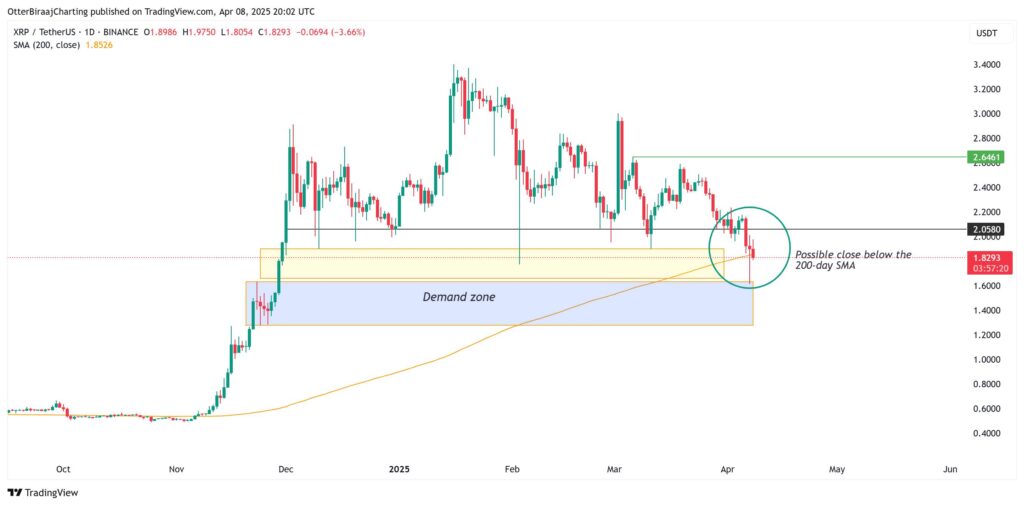XRP, the digital asset associated with the Ripple network, has found itself on a rollercoaster ride of market activity since it peaked at $3.40 on January 16, 2025. In the last three months, the cryptocurrency has plummeted by a staggering 46%, leading many investors to watch closely as they navigate this volatile landscape. Despite this downturn, data from Glassnode reveals that a significant 81.6% of XRP’s circulating supply remains profitable, although this figure has dipped from its year-high of 92%. This information is crucial as it underscores the capacity for holders to maintain some level of value in their investments, even amid corrections.
“Despite a 46% drop in value over the past three months, the retention of profit for XRP holders signals potential resilience in the market.”
In the broader landscape of cryptocurrencies, XRP isn’t alone in this narrative. Comparatively, Tron (TRX) boasts a slightly higher profit supply at 84.6%, while Bitcoin (BTC), Ether (ETH), and Solana (SOL) show percentages of 76.8%, 44.9%, and 31.6% respectively. This data illustrates not only XRP’s unique position but also highlights the ongoing battle for investor confidence across the crypto spectrum.
Market sentiment, especially among Korean traders, has shifted recently. Initially, traders on platforms like Upbit and Bybit were instrumental in buying XRP during its initial dip below $2 on February 3, propelling the asset back to $2.89 by mid-February. However, a recent influx of sell orders—62% of trades being sales over a two-day window—has turned the tide. This aggressive selling has resulted in net sales of $120 million in XRP, suggesting a cautious atmosphere among investors in the region.
“Korean traders executed 1.4 million trades on the XRP/KRW pair, reflecting a notable bearish sentiment.”
Compounding these market challenges, XRP recently broke below a significant support level at $2, marking a new yearly low of $1.61 on April 7, before attempting to stabilize and reclaim that critical price point shortly after. Analysts observe that if XRP fails to maintain above $2, the asset may enter a prolonged corrective phase, with significant demand zones identified between $1.63 and $1.27 indicating potential accumulation areas for investors.
As XRP continues to dance on the edge of volatility, the implications of its performance resonate throughout the crypto markets, revealing the ongoing complexities and challenges faced by traders and investors alike. The market remains charged with uncertainty, emphasizing the importance of understanding the nuances of price movements and investor sentiments in these turbulent times.
XRP Market Analysis and Implications for Investors
The recent performance of XRP has raised concerns among investors, particularly regarding its profitability and trading sentiment. Here are the key points that could impact the lives of current and potential investors:
- Significant Price Drop: XRP has fallen by 46% in the last three months, reaching a low of $1.61, which emphasizes the volatility of cryptocurrency investments.
- Profitability of Holdings:
- Currently, 81.6% of XRP’s circulating supply remains profitable, although this is down from 92% earlier in the year.
- This statistic indicates that many holders are still in a favorable position despite recent price declines.
- Korean Market Trends:
- Korean traders have played a crucial role in the XRP market, with recent data showing a shift to a predominantly bearish sentiment.
- 62% of trades in the XRP/KRW pair were sell orders, highlighting a lack of confidence among retail investors.
- Major Sell-offs:
- Over $1 billion in positions was offloaded at an average price of $2.10, indicating significant selling pressure.
- This may suggest that long-term investors are beginning to lose faith in XRP’s future performance.
- Trading Indicators:
- XRP’s price action reveals a bearish market structure, with traders closely monitoring key support levels.
- The potential loss of the $2 support level may foreshadow continued volatility and price corrections.
- Future Accumulation Zone:
- The key demand zone for XRP is identified between $1.63 and $1.27, where accumulation could occur if traders perceive a potential rebound.
Understanding these factors can help investors make informed decisions in a tumultuous financial landscape.
Understanding XRP’s Current Market Dynamics: A Comparative Analysis
XRP has certainly seen its ups and downs in recent months, particularly following its peak of $3.40 in January 2025. With a notable drop of 46% over three months, it’s crucial to analyze how XRP’s performance stacks up against its competitors, especially in the dynamic landscape of cryptocurrencies. One of the significant points of interest lies in the fact that 81.6% of XRP’s circulating supply remains profitable despite its recent losses. This statistic, although a dip from earlier highs, still indicates a degree of resilience among XRP holders compared to Bitcoin (BTC), Ether (ETH), and Solana (SOL), which show lower profit percentages in their supplies.
When we consider the competitive advantages, it’s evident that XRP’s high percentage of profitable circulating supply gives it an edge in attracting long-term investors. Unlike many altcoins, XRP’s profitability can instill confidence among those looking to hold through market fluctuations. On the downside, the increasing selling pressure, particularly from Korean XRP traders, signals a shifting sentiment that could deter new investment. The data suggests a bearish outlook as a significant portion of trades on Korean markets skewed towards selling, which raises concerns over retail confidence.
Comparatively, Bitcoin and Ethereum, with 76.8% and 44.9% of their supplies in profit respectively, have demonstrated stronger market stability and broader investor confidence. This stability is essential as it supports the narrative that these more established cryptos may serve as safer investments during turbulent times, potentially attracting risk-averse investors away from XRP.
The situation could create problems for XRP if retail sentiment continues to wane, particularly as heavy selling from long-term holders and new investors further erodes confidence. The evolving narrative suggests that if confidence in XRP continues to decline, it may push investors towards more stable alternatives like BTC or ETH, causing a ripple effect that could further destabilize XRP’s market position.
In terms of who stands to benefit from XRP’s current scenario, those who have held onto XRP during the downturn, particularly long-term investors, may find opportunities for future appreciation as market conditions change. Conversely, potential investors or new entrants may face challenges navigating the bearish structure of XRP, especially with ongoing volatility and decreasing liquidity from retail markets.
In essence, as XRP attempts to stabilize, its future hinges not only on its internal dynamics but also on external market forces that could either bolster its position or create further challenges. Observing how XRP responds to the actions of its competitors and adapting to shifting trader sentiments will be key in determining its trajectory in the coming months.

















